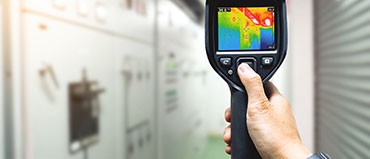
In recent years, near-infrared (NIR) imaging has emerged as a vital tool across various fields, particularly in healthcare, where its capabilities are transforming diagnostics, surgery, and research. By using light wavelengths from approximately 700 to 2500 nanometers (nm), NIR imaging offers the advantage of deeper tissue penetration than visible light while minimizing damage and providing clear visualization. This non-invasive imaging technology has shown promising applications in fields like oncology, neurology, and vascular surgery, driving its rapid market growth.
The global near infrared imaging market growth forecasted to transform from USD 1.0 billion in 2023 to USD 1.6 billion by 2028, driven by a CAGR of 10.2%. Technological advancements and an increasing number of surgical procedures, coupled with the adoption of hybrid NIR imaging technologies, are the key factors driving the growth of this market. In medicine, NIR imaging is used for functional brain imaging, tumor detection, vascular imaging, and drug delivery monitoring. The food industry benefits from NIR imaging for quality control and inspection of food products. Industrial applications include quality control, defect detection, and material characterization.
Download an Illustrative overview: https://www.marketsandmarkets.com/pdfdownloadNew.asp?id=174869738
What is Near-Infrared Imaging?
Near-infrared imaging refers to the use of NIR light, which has longer wavelengths than visible light, to visualize structures within biological tissues and materials. The unique properties of NIR light enable it to penetrate deeply into tissues, allowing for effective imaging of areas that traditional imaging methods may not reach as efficiently. Additionally, NIR light is absorbed minimally by water and hemoglobin, making it highly suitable for imaging human tissues.
NIR imaging is commonly used in conjunction with fluorescent dyes, such as indocyanine green (ICG), which can target specific tissues or structures. When these dyes are injected or applied, they emit fluorescence that NIR cameras detect, allowing for high-contrast imaging.
Major Applications of Near-Infrared Imaging
Near-infrared imaging is revolutionizing a number of medical procedures and has a range of applications across the healthcare sector. Here are some of the key areas where NIR imaging is making a significant impact:
- Oncological Imaging: One of the most impactful applications of NIR imaging is in cancer diagnosis and surgery. NIR imaging can help detect tumors by highlighting abnormal tissue growth and guiding surgeons in real time to ensure complete removal. Fluorescent markers that bind specifically to cancer cells can be injected, making tumors visible during surgery and helping reduce the risk of leaving malignant tissue behind.
- Cardiovascular and Vascular Imaging: Vascular surgeons use NIR imaging to assess blood flow, identify blockages, and monitor the health of blood vessels during procedures. This technique allows for quick and effective visualization of vascular structures, which can improve the accuracy of surgeries and reduce patient recovery times.
- Neurosurgery: NIR imaging is being used to visualize critical neural structures and ensure that important areas of the brain are not damaged during surgery. By distinguishing between different types of tissue, NIR imaging helps surgeons identify areas that need protection or removal, reducing the risk of complications and improving patient outcomes.
- Gastrointestinal Imaging: NIR imaging is also gaining traction in gastrointestinal surgeries, where it aids in the detection of cancerous tissue and polyps. It can help surgeons see beyond the surface, providing real-time visualization of areas with limited accessibility, which is essential in minimally invasive surgeries.
- Sentinel Lymph Node Mapping: This technique, commonly used in breast cancer and melanoma cases, involves locating sentinel lymph nodes—the first lymph nodes to which cancer cells are likely to spread. NIR imaging, combined with fluorescence agents, can accurately highlight sentinel lymph nodes, allowing for targeted biopsies and more precise assessments of cancer metastasis.
- Drug Delivery and Therapeutics Monitoring: Beyond surgical applications, NIR imaging is being applied in drug delivery research to track the distribution and effectiveness of treatments. By labeling drugs with NIR dyes, researchers can observe their movement through the body and better understand drug interactions, dosage requirements, and potential side effects.
Advancements in Near-Infrared Imaging Technology
The growth of the near-infrared imaging market has been fueled by continuous technological innovations. These advancements not only improve the quality of imaging but also expand its applications. Some notable innovations include:
- Enhanced Fluorescent Probes: Traditional fluorescent agents such as indocyanine green (ICG) are commonly used in NIR imaging, but new probes are being developed that offer higher specificity, longer-lasting fluorescence, and greater biocompatibility. Innovations like dual-labeling probes, which attach to multiple biomarkers, allow for multi-target imaging, providing a comprehensive view of tissues.
- Miniaturization and Portable Devices: Advances in device miniaturization have led to the development of portable NIR imaging equipment, making the technology more accessible and adaptable to a wider range of settings. These portable devices allow for bedside or in-field imaging, which is especially beneficial in emergency situations, remote areas, and resource-limited settings.
- Integration with Artificial Intelligence (AI): AI is enhancing NIR imaging by providing more precise analysis of captured images. Through machine learning algorithms, AI can assist in identifying patterns, interpreting imaging data, and detecting anomalies, which helps clinicians make faster and more accurate diagnoses.
- Hybrid Imaging Systems: Hybrid systems that combine NIR imaging with other imaging modalities, such as magnetic resonance imaging (MRI) or computed tomography (CT), are being developed to provide a multi-dimensional view of the targeted area. These systems combine the high spatial resolution of MRI or CT with the functional insights of NIR, offering comprehensive insights for complex diagnoses and surgeries.
- Wearable NIR Imaging Devices: Wearable NIR imaging devices are emerging for continuous monitoring applications, such as in neurology and patient rehabilitation. These wearable devices allow for non-invasive tracking of changes in brain activity or tissue oxygenation, offering insights for both clinical research and patient care.
Request Sample Pages: https://www.marketsandmarkets.com/requestsampleNew.asp?id=174869738
Market Trends and Drivers
The global near-infrared imaging market is experiencing rapid growth, driven by several key trends and factors:
- Rising Prevalence of Cancer and Chronic Diseases: The increasing incidence of cancer and chronic diseases like cardiovascular disorders has heightened the demand for diagnostic imaging technologies, including NIR imaging. This demand is expected to continue as early detection and precision surgery become priorities in healthcare.
- Growth in Minimally Invasive Surgeries: The trend towards minimally invasive surgeries is pushing the adoption of NIR imaging, as this technology allows surgeons to work with precision while minimizing tissue damage. With patients preferring procedures that offer faster recovery times and fewer complications, NIR imaging is becoming an essential tool for surgeons worldwide.
- Government Support and Increased R&D Investments: Governments around the world are investing in research and development to advance medical imaging technologies. For example, the U.S. National Institutes of Health (NIH) and other institutions provide grants for studies in optical imaging technologies, supporting the development and adoption of NIR imaging solutions.
- Increasing Awareness of Fluorescent Imaging in Surgery: The healthcare community is becoming more aware of the benefits of fluorescent-guided imaging, especially in terms of precision and reduced operating times. This is encouraging hospitals and clinics to invest in NIR imaging systems for a range of surgical applications.
- Expanding Applications in Non-Clinical Settings: Beyond the clinical environment, NIR imaging is also being explored for use in fields such as agriculture, food quality inspection, and environmental monitoring. For instance, NIR imaging can help assess crop health, detect contaminants in food, and monitor pollution, contributing to its broader market expansion.
Challenges in the Near-Infrared Imaging Market
While the NIR imaging market shows significant promise, it also faces certain challenges that may impact its growth:
- High Costs of NIR Imaging Systems: The cost of acquiring, installing, and maintaining NIR imaging systems can be prohibitive for smaller healthcare facilities, particularly in developing regions. The need for skilled personnel to operate these systems further adds to the cost barrier.
- Complex Regulatory Landscape: As with any medical imaging technology, NIR imaging systems must comply with strict regulatory standards to ensure patient safety and data accuracy. Navigating this complex landscape can be a time-consuming and costly process, potentially delaying product launches.
- Limited Awareness and Adoption: In certain regions, awareness of the benefits of NIR imaging remains low, which can affect market adoption. This is especially true in rural or underserved areas, where healthcare infrastructure may lack the capacity to adopt advanced imaging technologies.
- Technical Limitations: Although NIR imaging offers advantages over visible light imaging, it has limitations in terms of depth penetration and image resolution compared to other imaging methods, such as MRI or CT. These limitations may restrict its application in certain cases.
Future Prospects of the Near-Infrared Imaging Market
The future of the near-infrared imaging market looks promising, with continued advancements likely to expand its applications and improve its accessibility. Several trends may shape the market in the coming years:
- Increased Focus on AI-Driven Analysis: The integration of AI is expected to deepen, with more advanced algorithms developed to enhance the accuracy and speed of image analysis. This will enable more automated diagnostics and help clinicians make quicker, evidence-based decisions.
- Development of Novel Fluorescent Agents: Research into new fluorescent agents that offer better contrast and are safer for patient use will continue, potentially leading to a wider range of applications and even higher-quality imaging.
- Greater Penetration in Emerging Markets: As the cost of NIR imaging systems decreases, more facilities in emerging markets will be able to adopt this technology, improving healthcare access and diagnostics in these regions.
Get 10% Free Customization on this Report: https://www.marketsandmarkets.com/requestCustomizationNew.asp?id=174869738
Conclusion
The near-infrared imaging market is poised for growth, driven by its expanding applications in surgery, diagnostics, and patient monitoring. With technological advancements such as AI integration, hybrid imaging systems, and novel fluorescent dyes, NIR imaging will play a pivotal role in enhancing healthcare delivery, enabling precision medicine, and supporting critical research initiatives. As the market continues to evolve, near-infrared imaging will remain at the forefront of medical innovation, offering clinicians and researchers new ways to understand, diagnose, and treat complex health conditions.



